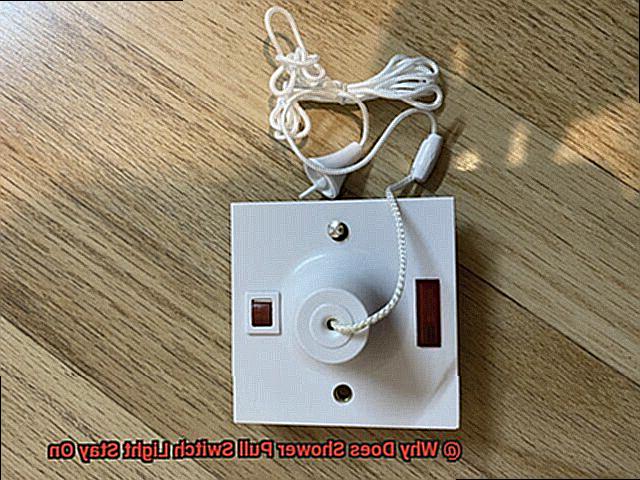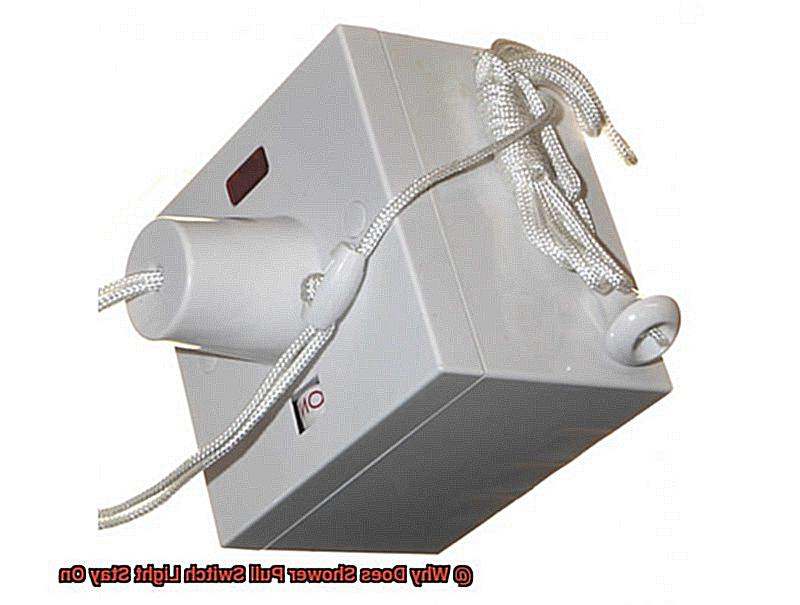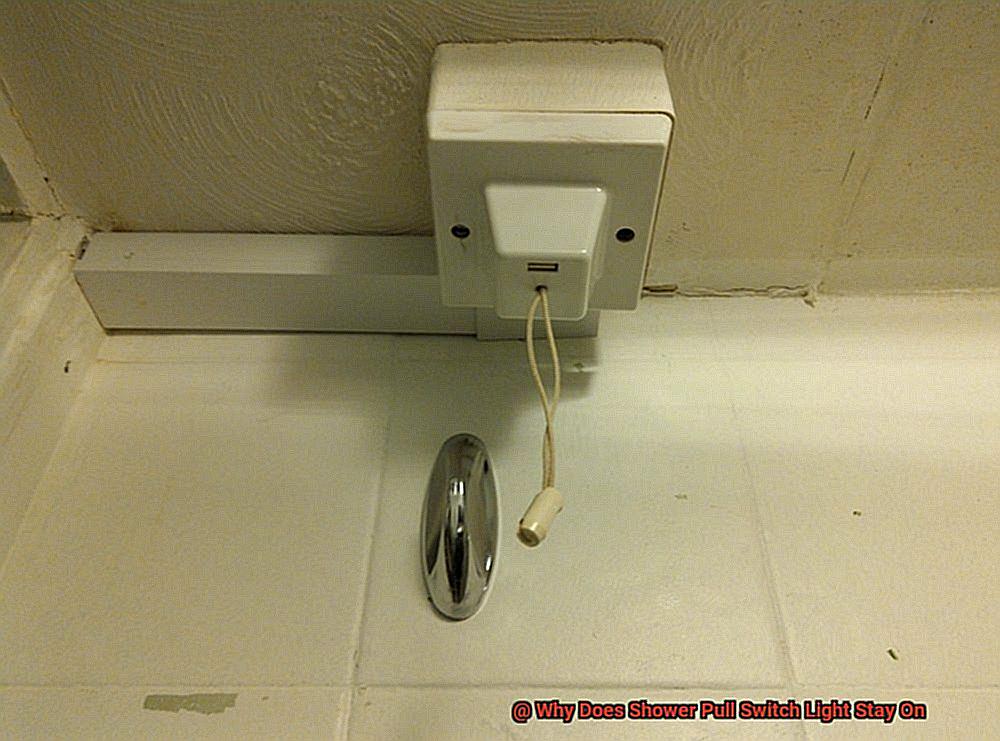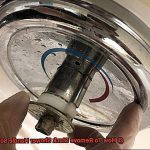Imagine this scenario: you’ve just enjoyed a refreshing shower, and as you reach to switch off the light, you realize that the pull switch isn’t functioning properly. The light stays on, leaving you perplexed and unsure of what to do next. It’s a frustrating situation, but rest assured, it’s not uncommon.
A shower pull switch is a typical mechanism utilized to turn on and off the bathroom light. As the name suggests, you pull on the switch to operate it. Although it appears uncomplicated, several factors can cause the switch to malfunction and leave the light on even after pulling the cord.
So why does your shower pull switch light stay on? There are various reasons for this issue: a defective switch, a loose connection, incorrect wiring setup or even water damage. Identifying the source of the problem is crucial in finding a solution and preventing any potential electrical hazards.

In this blog post, we will delve into each possible culprit in greater detail and provide tips on how to troubleshoot and fix the issue. By the end of this article, you’ll have gained valuable insight into why your shower pull switch light stays on and how best to address it.
Contents
What Causes Shower Pull Switch Light to Stay On?
There are several reasons why this may happen, and it’s important to identify the root cause to prevent any further issues.
One of the most common reasons for a shower pull switch light to stay on is a faulty switch. Over time, the switch may become worn out or damaged, causing it to remain in the “on” position. This issue may require replacing the switch entirely to fix the problem.
Another possible cause of a shower pull switch light staying on is a wiring issue. If the wiring connected to the switch is damaged, frayed, or loose, it can cause electrical current to continue flowing to the light even when the switch is turned off. This issue can be dangerous and should be addressed immediately by a licensed electrician.
In some cases, a malfunctioning light bulb or fixture can also cause the shower pull switch light to stay on. If the bulb is not screwed in tightly or is defective, it may continue to emit light even when the switch is turned off. Similarly, if the fixture itself is damaged or faulty, it may not respond properly to the switch’s position and remain illuminated.
Overall, there are several potential causes of a shower pull switch light staying on. By identifying and addressing these issues promptly, homeowners can ensure that their bathrooms remain safe and functional for years to come.
Remember that attempting to fix electrical issues on your own can be dangerous and should only be done by a licensed electrician. They have the knowledge and tools needed to safely diagnose and repair any wiring or switch issues.
Loose or Faulty Wiring Connection
The culprit is likely a loose or faulty wiring connection. This issue can occur in both the switch itself and in the wiring that connects the switch to the light fixture. But why does this happen?
A loose connection can cause the switch to remain in the “on” position even when it’s supposed to be off. In this scenario, the wires connecting the switch to the light fixture are not securely connected, or they could be frayed or damaged over time. When this occurs, electricity may continue to flow to the light even when the switch is turned off, causing it to stay illuminated.
Similarly, a faulty wiring connection can also cause your shower pull switch light to stay on. This happens when there’s a break in the electrical circuit somewhere along the line, preventing electricity from flowing correctly between the switch and the light fixture. To address this issue, troubleshooting involves inspecting the wiring connections for signs of damage or wear and repairing or replacing any components that appear to be faulty.
It’s crucial to address loose or faulty wiring connections immediately for safety reasons. If you’re not comfortable working with electrical components yourself, it’s always best to consult a professional electrician to diagnose and repair any issues with your bathroom lighting system.
Faulty Switch
If you’ve ever found yourself showering in the dark, you know how unsettling it can be. A stubborn shower pull switch light that refuses to turn off can quickly turn your soothing shower into a horror movie scene. But fear not. The most likely culprit is a faulty switch, and diagnosing and replacing it is easier than you might think.
A faulty switch is a common reason why a shower pull switch light stays on. It can be caused by several factors, such as worn-out contacts, damaged electrical components, or loose connections. However, you don’t need to be an electrical whiz to diagnose and replace a faulty switch.
One way to diagnose a faulty switch is to use a multimeter. This device measures electrical resistance, voltage, and current and can help you determine if the switch is faulty. To test the switch, simply disconnect the power supply and remove the switch cover. Then set the multimeter to measure continuity and place the probes on each end of the switch contacts. If there is no continuity, it means that the switch is faulty and needs to be replaced.

Another way to diagnose a faulty switch is to check for signs of damage or wear and tear on the switch contacts. Worn-out or damaged contacts will not be able to make proper electrical connections when the switch is turned on or off. Additionally, loose connections can also cause the switch to malfunction.
Replacing a faulty switch requires basic electrical knowledge but can be done easily with proper precautions.

Before replacing the switch, you should turn off the power supply and remove the switch cover. Then, disconnect the wires from the old switch and connect them to the new one, ensuring that they are properly secured.
Finally, reattach the switch cover and turn on the power supply to test if it is working correctly.
Professional Assistance for Electrical Issues
While it may be tempting to roll up your sleeves and try to fix them on your own, it’s always best to seek professional assistance.
For example, let’s say you’re dealing with a shower pull switch light that just won’t turn off. While it may seem like a minor issue, trying to fix it without the proper expertise can be dangerous and even cause more problems.
That’s where professional electricians come in. They have the necessary knowledge and experience to diagnose and fix electrical issues safely and efficiently. Plus, they have all the right tools and equipment to handle wiring and components with ease.
But it’s not just about getting your lights back on – professional electricians also ensure that any repairs or replacements meet safety standards and comply with local building codes. This is crucial because shoddy electrical work can lead to serious safety hazards, including electrical shock or fire.
In fact, attempting to fix an electrical issue on your own can even void warranties or insurance coverage you may have. If something goes wrong and you’ve made the repairs yourself, your insurance company could deny your claim altogether.
DIY Solutions for Fixing Wiring Problems
DIY solutions for fixing wiring problems can save you a lot of money, but it’s important to take proper precautions before you start. Safety should always come first, so follow these steps to ensure your safety and fix your wiring problem.
Step 1: Turn off all power sources and wear protective gear.
Before starting any DIY project involving electrical work, it’s crucial to turn off all power sources and wear protective gear. This will protect you from any potential accidents or injuries that could occur while working with electricity.
Step 2: Check the wiring connections.
If your shower pull switch light stays on, the problem might be with the wiring. Start by removing the cover plate and inspecting the wires’ condition. If they are loose or damaged, tighten or replace them as necessary.
Step 3: Replace the switch if necessary.
If the wiring connections seem okay, the issue might be with the switch itself. In this case, you will need to replace it. Before replacing the switch, make sure to turn off all power sources and disconnect the wires from the old switch.
Step 4: Connect wires correctly and test the switch.
When installing a new switch, make sure to connect the wires correctly by following the manufacturer’s instructions. Once installed, turn on the power and test the switch to ensure it is working correctly.
Step 5: Call a professional if needed.
If you’re not confident in your DIY skills or feel uncomfortable working with electricity, it’s best to call a professional electrician to address the issue. Remember that safety should always come first when dealing with electrical problems.
Fixing wiring problems yourself can save you money, but it’s important to prioritize your safety first. Turn off all power sources, wear protective gear, check wiring connections, replace the switch if necessary, and connect wires correctly. If you’re not confident in your skills, don’t hesitate to call a professional electrician.
Safety Precautions When Working with Electrical Systems
Working with electrical systems is a crucial task that requires proper safety measures to be taken to ensure the safety of everyone involved. Here are seven essential safety precautions that you should keep in mind when working with electrical systems.
The first and most important step is to turn off the power before starting any work on the system. This can be achieved by shutting off the circuit breaker or removing the fuse that controls that particular circuit. However, even after turning off the power, it’s critical to test for voltage using a voltage tester or multimeter to ensure that there is no live current in the system.
Protective gear is essential when working with electrical systems. Make sure you wear gloves, safety glasses, and non-conductive footwear to protect against electric shock and burns. It’s also important to use insulated tools when working on electrical systems to prevent accidental contact with live wires.
Avoid working on electrical systems in wet or damp conditions as this significantly increases the risk of electric shock. Ensure that the area you’re working in is dry and well-ventilated.
When working with electrical systems, maintaining a safe distance from any live wires or sources of electricity is crucial. Never assume that a wire is not live just because you turned off the power; always treat all wires as live.
If you’re unsure about how to safely work on an electrical system or encounter a problem that you cannot fix yourself, seek professional help from a licensed electrician. Don’t take unnecessary risks when it comes to your safety and others around you.
7u59kaoOcZo” >
Conclusion
To sum it up, a shower pull switch light that stays on can be a major inconvenience and pose safety risks. However, with proper knowledge and action, homeowners can keep their bathroom lighting system secure and functional. A malfunctioning switch, loose or damaged wiring connections, and faulty bulbs or fixtures are some of the common culprits behind this issue.
It’s important to address these problems promptly to avoid potential electrical hazards. Although DIY solutions for fixing wiring issues can save money, safety should always come first when dealing with electricity. Before starting any work, make sure to turn off all power sources, wear protective gear like gloves and safety glasses, check wiring connections thoroughly, replace the switch if necessary and connect wires correctly.
If you’re not confident in your skills or feel uncomfortable working with electricity, it’s best to call a professional electrician who has the expertise and equipment required for safe repairs.
When working with electrical systems, taking proper precautions is critical. Always turn off the power before starting work, avoid wet or damp conditions while working on electrical systems and maintain a safe distance from live wires at all times.





